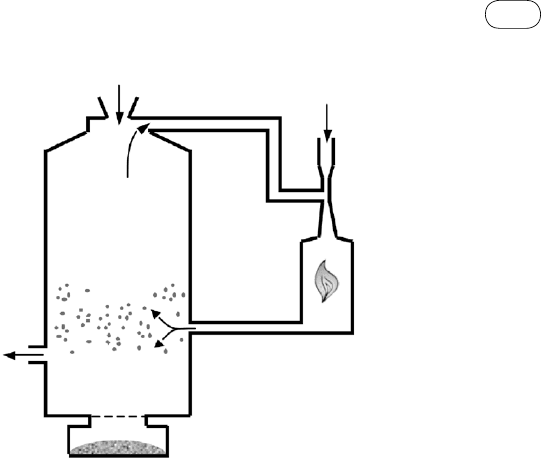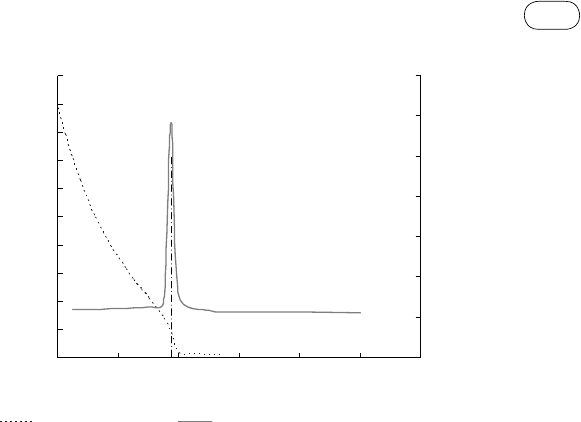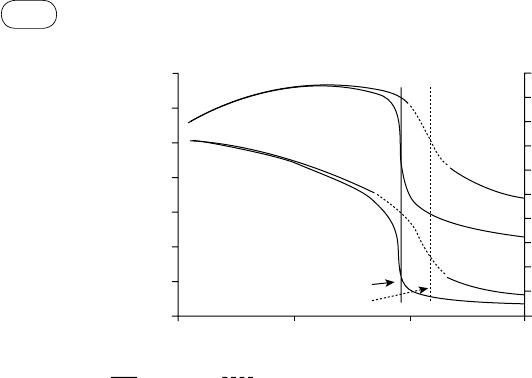Basu P. Biomass Gasification and Pyrolysis: Practical Design and Theory
Подождите немного. Документ загружается.


227
6.11 Performance and Operating Issues
Top gas
burner
Venturi
Air
Fuel
Gas
Ash pit
Pyrolysis
zone
Reduction
zone
FIGure 6.24 Gasifier with an aspirator for cracking tar. Fresh air picks up the tar from the
gasifier and injects it into the high-temperature combustion zone.
H = fractional of hydrogen in the fuel in dry basis (–)
HHV = higher heating value (kJ/kg)
HHV
d
= higher heating value of biomass on dry basis (MJ/kg)
HHV
daf
= higher heating value of biomass on dry ash–free basis (MJ/kg)
H
bed
= height of the bed (m)
H
g
= enthalpy of steam at gasification temperature (kJ/kg)
H
in
= heat of the input gas (kJ)
[H
2
O] = concentration of steam (–)
k = rate constant (s
–1
)
k
0
= pre-exponential constant in the Arrhenius equation (s
–1
)
LHV
bm
= lower heating value of the biomass (MJ/kg)
LHV
daf
= lower heating value of biomass on dry ash-free basis (MJ/kg)
LHV
f
= lower heating value of the solid fuel (MJ/Nm
3
)
LHV
g
= lower heating value of the produced gas (MJ/Nm
3
)
m = mass-flow rate of carbon or char (kg/s)
m
th
= theoretical air requirement for complete combustion of a unit of biomass (kg/kg)
M
a
= amount of air required for gasification of unit mass of biomass (kg/kg)
M = fractional of moisture in the fuel (–)
M
daf
= moisture based on dry ash-free basis
M
f
= fuel flow rate (kg/s)
M
fh
= quantity of steam (kg/s)
M
g
= gas produced (kg/s)
n = order of reaction (–)
n
i
= number of moles of species i (–)
N = fractional of nitrogen in the fuel in dry basis (–)
n
total
= total number of moles

228
chapter
|
6 Design of Biomass Gasifiers
O = fractional of oxygen in the fuel in dry basis (–)
P
c
= amount of char produced per nm
3
of product gas (kg/nm
3
)
q
c
= heating value of char (kJ/kg)
Q = power output of the gasifier (MWth)
Q
ext
= external heat addition to the system (kJ/Nm
3
)
Q
g
= Lower heating value of the product gas from gasification (MJ/Nm
3
)
Q
gasification
= heat supplied to gasify 1 mol of biomass (kJ/mol)
Q
loss
= heat loss from the gasifier (kJ/Nm
3
)
r = steam gasification reaction rate (kg/s)
R = universal gas constant (0.008314
kJ/mol.K)
S = fractional of sulfur in the fuel in dry basis (–)
SC = steam to carbon molar ratio (–)
t = time (s)
T = temperature (K)
T
f
= gas temperature at the exit (°C)
T
g
= gas temperature (°C)
T
0
= gas temperature at the entrance (°C)
U
g
= fluidizing velocity (m/s)
V = volume of the fluidized bed (m
3
)
V
bed
= volume of the bed (m
3
)
V
daf
= volatile based on dry mass-free basis
V
g
= gas generation rate (m
3
/s)
V
g
= volumetric flow rate of product gas (Nm
3
/s)
V
i
= volumetric fraction of gas species i (–)
W = total steam needed in Eq. 6.22 (kg/s)
W
in
= rate of the char moving in (kg/s)
W
out
= rate of the char moving out (kg/s)
x
char
= weight of the reacting char (kg)
X = fraction of char in the feed converted (–)
X
c
= fixed carbon fraction in the fuel (kg carbon/kg dry fuel)
X
char
= char fraction in bed (–)
X
g
= fraction of steam used up in gasification
ε = voidage of the bed (–)
λ
I
= Lagrangian multiplier for species i (–)
ρ
g
= density of air at the opening temperature and pressure of the gasifier (kg/m
3
)
θ = residence time of char in bed or reactor (s)
ρ
b
= bed density (kg/m
3
)
ρ
s
= density of bed solids (kg/m
3
)
η
gef
= gasifier efficiency (–)
η
ceff
= cold gas efficiency (–)
η
cg
= cold gas efficiency of the gasifier (–)
η
hg
= hot gas efficiency of the gasifier (–)
η
net
= net gasification efficiency of the gasifier (–)
ΔH
T
= heat of formation at temperature T (kJ/mol)

Hydrothermal Gasification
of Biomass
Chapter 7
Biomass Gasification and Pyrolysis. DOI: 10.1016/B978-0-12-374988-8.00007-6
Copyright © 2010 Prabir Basu. Published by Elsevier Inc. All rights reserved.
229
7.1 IntroductIon
In the mid-1970s Sanjay Amin, a graduate student working at the Massachu-
setts Institute of Technology (MIT), was studying the decomposition of organic
compounds in hot water (steam reforming):
C H O H O CO H
6 10 5 2 2 2
7 6 12+ → + (7.1)
While conducting an experiment in subcritical water, he observed that in addi-
tion to producing hydrogen and carbon dioxide, the reaction was producing
much char and tars. Herguido et
al. (1992) also made similar observations in
the steam gasification of biomass at atmospheric pressure.
Sanjay interestingly noted that when he raised the water above its “critical
state,” the tar that formed in the subcritical state disappeared entirely (Amin
et al., 1975). This important finding kick-started research and development on
supercritical water oxidation (SCWO) for disposal of organic waste materials
(Tester et
al., 1993), which has now become a commercial option for disposal
of highly contaminated organic wastes (Shaw and Dahmen, 2000).
Biomass in general contains substantially more moisture than do fossil
fuels like coal. Some aquatic species, such as water hyacinth, or waste products,
such as raw sewage, can have water contents exceeding 90%. Thermal gasifica-
tion, where air, oxygen, or subcritical steam is the gasification medium, is
very effective for dry biomass, but it becomes very inefficient for a high-
moisture biomass because the moisture must be substantially driven away
before thermal gasification can begin; in addition, a large amount of the extra
energy (~2260
kJ/kg moisture) is consumed in its evaporation. For example,
Yoshida et
al. (2003) saw the efficiency of their thermal gasification system
reduce from 61 to 27% while the water content of the feed increased from 5 to
75%. So, for gasification of very wet biomass, some other means such as
anaerobic digestion (see Section 2.2) and hydrothermal gasification in high-
pressure hot water are preferable because the water in these processes is not a

230
chapter
|
7 Hydrothermal Gasification of Biomass
liability as it is in thermal gasification. Instead it serves as a reaction medium
and a reactant.
The efficiencies of these processes do not decrease with moisture content.
For anaerobic digestion and supercritical gasification, Yoshida et
al. (2003)
found the gasification efficiency to remain nearly unchanged, at 31% and
51%, respectively, even when the moisture in the biomass increased from 5
to 75%.
A major limitation of anaerobic digestion is that it is very slow, with a rela-
tively low efficiency and, most important, it produces methane only, no hydro-
gen. If hydrogen is the desired product, as is often the case, an additional step
of steam reforming the methane (CH
4
+ H
2
O = CO + 3H
2
) must be added to
the anaerobic digestion process.
Hydrothermal gasification involves gasification in an aqueous medium at
very a high temperature and pressure exceeding or close to its critical value.
While subcritical water has been used effectively for hydrothermal reaction,
supercritical water has attracted more attention owing to its unique features.
Supercritical water offers rapid hydrolysis of biomass, high solubility of inter-
mediate reaction products, including gases, and a high ion product near (but
below) the critical point that helps ionic reaction. These features make super-
critical water an excellent reaction medium for gasification, oxidation, and
synthesis.
This chapter deals primarily with hydrothermal gasification of biomass in
supercritical water. It explains the properties of supercritical water and the
biomass conversion process in it. The effects of different parameters on SCW
gasification and design considerations for the SCW gasification plants are also
presented.
7.2 SupercrItIcal Water
Water above its critical temperature (374.29 °C) and pressure (22.089 MPa) is
called supercritical (Figure 7.1). Water or steam below this pressure and tem-
perature is called subcritical. The term water in a conventional sense may not
be applicable to SCW except for its chemical formula, H
2
O, because above the
critical temperature SCW is neither water nor steam. It has a waterlike density
but a steam like diffusivity. Table 7.1 compares the properties of subcritical
water and steam with those of SCW, indicating that SCW’s properties are
intermediate between the liquid and gaseous states of water in subcritical
pressure; descriptions of each follow the table.
Figure 7.1 shows that the higher the temperature, the higher the pressure
required for water to be in its liquid phase. Above a critical point the line sepa-
rating the two phases disappears, suggesting that the division between the liquid
and vapor phases disappears. Temperature and pressure at this point are known
as critical temperature, and critical pressure, above which water attains super-
critical state and hence is called supercritical (SCW).

231
7.2 Supercritical Water
22.1
374
0.1
611 (Pa)
0.01 100
Ice
Water
Vapor
Critical point
Temperature (°C)
Pressure (MPa)
Supercritical
water
FIG
ure
7.1
Phase diagram of water showing the supercritical region.
TABLE 7.1 Properties of Supercritical and Subcritical Water
Property
Subcritical
Water
Supercritical
Water
Supercritical
CO
2
Subcritical
Steam
Temperature (°C) 25 400 55 150
Pressure (MPa) 0.1 30 28 0.1
Density, kg/m
3
997* 358* 835 0.52*
Dynamic viscosity, µ
(kg/m.s)
890.8 × 10
−6
43.83 × 10
−6
* 0.702 × 10
−6
14.19 × 10
−6
*
Diffusivity of small
particles (m
2
/s)
~1.0 × 10
−9
** ~1.0 × 10
−8
** ~1.0 × 10
−5
**
Dielectric constant*** 78.46 5.91 1.0
Thermal conductivity,
λ (w/m.k)
607 × 10
−3
* 330 × 10
−3
* 28.8 × 10
−3
*
Prandtl number,
C
p
µ/λ
6.13 3.33 0.97
*Haar et al., 1984; **Serani et al., 2008; ***Uematsu and Franck, 1980.
Subcritical water (T < T
sat
; P < P
c
). When the pressure is below
its critical value, P
c
, and the temperature is below its critical value, T
c
, the
fluid is called subcritical. If the temperature is below its saturation value,
the fluid is known as subcritical water, as shown in the lower left block of
Figure 7.1.

232
chapter
|
7 Hydrothermal Gasification of Biomass
Subcritical steam (T > T
sat
; P < P
c
. Note: T may be above T
c
). When water
(below critical pressure) is heated, it experiences a drop in density and an
increase in enthalpy; this change is very sharp when the temperature of the
water just exceeds it saturation value, T
sat
. Above the saturation temperature,
but below the critical value, the fluid (H
2
O) is called subcritical steam. This
regime is shown below the saturation line in Figure 7.1.
Supercritical water (T > T
c
; P > P
c
). When heated above its critical pres-
sure, P
c
, water experiences a continuous transition from a liquidlike state
to a vapor like state. The vaporlike, supercritical, state is shown in the
upper right block in Figure 7.1. Unlike in the subcritical stage, no heat of
vaporization is needed for the transition from liquidlike to vaporlike.
Above the critical pressure, there is no saturation temperature separating
the liquid and vapor states. However, there is a temperature, called
pseudo-critical temperature, that corresponds to each pressure (>P
c
) above
which the transition from liquidlike to vaporlike takes place. The pseudo-
critical temperature is characterized by a sharp rise in the specific heat of
the fluid.
The pseudo-critical temperature depends on the pressure of the water. It
can be estimated within 1% accuracy by the following empirical equation
(Malhotra, 2006):
T P
F P P
T
T
T
P
P
P
F
sc
c c
* *
* *
* *
=
( )
= + −
( )
= =
0 1248 0 01424 0 0026
2
. . .
;
(7.2)
where T
sat
is the saturation temperature at pressure P; P
sat
is the saturation
pressure at temperature T; P
c
is the critical pressure of water, 22.089 MPa;
T
c
is the critical temperature of water, 374.29 °C; and T
sc
is the pseudo-
critical temperature at pressure P (P > P
c
).
7.2.1 properties of Supercritical Water
The critical point marks a significant change in the thermophysical properties
of water (Figure 7.2). There is a sharp rise in the specific heat near the critical
temperature followed by a similar drop. The thermal conductivity of water
drops from 0.330
W/m.K at 400 °C to 0.176
W/m.K at 425 °C. The drop in
molecular viscosity is also significant, although the viscosity starts rising with
temperature above the critical value. Above this critical point, water experi-
ences a dramatic change in its solvent nature primarily because of its loss of
hydrogen bonding. The dielectric constant of the water drops from a value of
about 80 in the ambient condition to about 10 at the critical point. This changes
the water from a highly polar solvent at an ambient condition to a nonpolar
solvent, like benzene, in a supercritical condition.

233
7.2 Supercritical Water
The change in density in supercritical water across its pseudo-critical tem-
perature is much more modest, however. For example, at 25
MPa it can drop
from about 1000 to 200
kg/m
3
while the water moves from a liquidlike to a
vaporlike state. At subcritical pressure, however, there is an order of magnitude
drop in density when the water goes past its saturation temperature. For example,
at 0.1
MPa or 1
atm of pressure, the density reduces from 1000 to 0.52
kg/m
3
as the temperature increases from 25 to 150 °C (refer to Table 7.1).
The most important feature of supercritical water is that we can “manipu-
late” and control its properties around its critical point simply by adjusting the
temperature and pressure. Supercritical water possesses a number of special
properties that distinguish it from ordinary water. Some of those properties
relevant to gasification are as follows:
The solvent property of water can be changed very strongly near or above
its critical point as a function of temperature and pressure.
Subcritical water is polar, but supercritical water is nonpolar because of its
low dielectric constant. This makes it a good solvent for nonpolar organic
compounds but a poor one for strongly polar inorganic salts. SCW can be
a solvent for gases, lignin, and carbohydrates, which show low solubility in
ordinary (subcritical) water. Good miscibility of intermediate solid organic
compounds as well as gaseous products in liquid SCW allows single-phase
chemical reactions during gasification, removing the interphase barrier of
mass transfer.
0
10
20
30
40
50
60
70
80
90
100
0 200 400 600 800 1000 1200
Temperature (°C)
Dielectric constant (–)
–20
0
20
40
60
80
100
120
Specific heat (kJ/kg.K)
dielectric constant specific heat
374 °C
FIG
ure
7.2
Specific heat of water above its critical pressure shows a peak at its pseudo-critical
temperature. Dielectric constant at 22.1
MPa, also plotted on this graph, shows rapid decline closer
to the critical temperature.

234
chapter
|
7 Hydrothermal Gasification of Biomass
SCW has a high density compared to subcritical steam at the same tempera-
ture. This feature favors the forward reaction between cellulose and water
to produce hydrogen.
Near its critical point, water has higher ion products ([H
+
][OH
−
]~10
–11
(mol/l)
2
) than it has in its subcritical state at ambient conditions (~10
−14
(mol/l)
2
) (Figure 7.3). Owing to this high [H
+
] and [OH
–
] ion, the water can
be an effective medium for acid- or base-catalyzed organic reactions (Serani
et
al., 2008). Above the critical point, however, the ion product drops
rapidly (~10
−24
(mol/l)
2
at 24 MPa), and the water becomes a poor medium
for ionic reactions.
Most ionic substances, such as inorganic salts, are soluble in subcritical
water but nearly insoluble under typical conditions of SCW gasifiers. As
the temperature rises past the critical point, the density as well as the ionic
product decreases (Figure 7.3). Thus, highly soluble common salt (NaCl)
becomes insoluble at higher temperatures above the critical point. This
tunable solubility property of SCW makes it relatively easy to separate the
salts as well as the gases from the product mixture in an SCW gasifier.
Gases, such as oxygen and carbon dioxide, are highly miscible in SCW,
allowing homogeneous reactions with organic molecules either for oxida-
tion or for gasification. This feature makes SCW an ideal medium for
destruction of hazardous chemical waste through SCWO.
SCW possesses excellent transport properties. Its density is lower than that
of subcritical water but much higher than that of subcritical steam. This,
along with other properties like low viscosity, low surface tension (surface
tension of water reduces from 7.2 × 10
−2
at 25 °C to 0.07 at 373 °C), and
high diffusivity greatly contribute to the SCW’s good transport property,
1400 –10
–12
–14
–16
–18
–20
–22
–24
–26
–28
–30
1200
1000
800
600
400
200
0
0 200
Density
Ionic product
Drop of physical properties
Density (kg/m
3
)
Log ionic product (mol
2
l
–2
)
400
Temperature (°C)
24 MPa
at 24 MPa
38 MPa
at 38 MPa
600
FIGure 7.3 At a given temperature, both the density and the ion product of water increase with
pressure. Data plotted for 24 MPa show that these values reduce quickly at the critical temperature,
but are slower at 38
MPa. The ion product is plotted as negative log.kw. (Source: Adapted from
Kritz, 2004; used with permission.)

235
7.2 Supercritical Water
which allows it to easily enter the pores of biomass for effective and fast
reactions.
Reduced hydrogen bonding is another important feature of SCW. The high
temperature and pressure break the hydrogen-bonded network of water
molecules.
Table 7.1 compares some of these water properties under subcritical and super-
critical conditions.
7.2.2 application of Supercritical Water in chemical reactions
Chemical reactions involve the mixing of reactants. If the mixing is incomplete,
the reaction will be incomplete, even if the right amounts of reactant and the
right temperature are available. The mixing is better when all reactants are
either in the gas phase or in the liquid phase compared to that when one reactant
is in the solid phase and the other is in the gas or liquid phase. The absence of
interphase resistance in a monophase reaction medium greatly improves the
mixing. The conventional thermal gasification of solid biomass in air or steam
involves heterogeneous mixing, and therefore the gas–solid interphase resis-
tance limits the conversion reactions.
Supercritical water allows reactions to take place in a single phase, as most
organic compounds and gases are completely miscible in it. It is thus a superior
reaction medium. Because the absence of interphase mass transfer resistance
facilitates better mixing and therefore higher conversion, SCW can be an excel-
lent medium for the following three types of reactions:
Hydrothermal gasification of biomass. SCW is an ideal medium for gas-
ification of very wet biomass, such as aquatic species and raw sewage,
which ordinarily have to be dried before they can be gasified economically.
SCW gasification produces gas at high pressure and thus obviates the need
for an expensive product gas compression step for transport or use in
combustion.
Synthesis reactions. A variety of organic reactions like hydrolysis and
molecular rearrangement can be effectively carried out in SCW, which
serves as a solvent, a reactant, and sometimes a catalyst. There is no need
for acid or base solvents, the disposal of which is often a problem.
Supercritical water oxidation. Complete miscibility of oxygen in SCW
helps harmful organic compounds to be easily oxidized and degraded. Thus,
SCW is an attractive means of turning pollutants into harmless oxides.
7.2.3 advantages of ScW Gasification over conventional
t
hermal
Gasification
The following are two broad routes for the production of energy or chemical
feedstock from biomass:

236
chapter
|
7 Hydrothermal Gasification of Biomass
Biological: Direct biophotolysis, indirect biophotolysis, biological reac-
tions, photofermentation, and dark fermentation are the five major biologi-
cal processes.
Thermochemical: Combustion, pyrolysis, liquefaction, and gasification are
the four main thermochemical processes.
Thermal conversion processes are relatively fast, taking minutes or seconds to
complete, while biological processes, which rely on enzymatic reactions, take
much longer, on the order of hours or even days. Thus, for commercial use,
thermochemical conversion is preferred.
Gasification may be carried out in air, oxygen, subcritical steam, or water
near or above its critical point. This chapter concerns hydrothermal gasification
of biomass above or very close to the water’s critical point to produce energy
and/or chemicals.
Conventional thermal gasification faces major problems from the forma
-
tion of undesired tar and char. The tar can condense on downstream equip
-
ment, causing serious operational problems, or it may polymerize to a
more complex structure, which is undesirable for hydrogen production. Char
residues contribute to energy loss and operational difficulties. Furthermore,
very wet biomass can be a major challenge to conventional thermal gasification
because it is difficult to economically convert if it contains more than 70%
moisture. The energy used in evaporating fuel moisture (2257
kJ/kg), which
effectively remains unrecovered, consumes a large part of the energy in the
product gas.
Gasification in supercritical water (SCWG) can largely overcome these
shortcomings, especially for very wet biomass or organic waste. For example,
the efficiency of thermal gasification of a biomass containing 80% water in
conventional steam reforming is only 10%, while that of hydrothermal gasifica-
tion in SCW can be as high as 70% (Dinjus and Kruse, 2004). Gasification in
near or supercritical water therefore offers the following benefits:
Tar production is low. The tar precursors, such as phenol molecules, are
completely soluble in SCW and so can be efficiently reformed in SCW
gasification.
SCWG achieves higher thermal efficiency for very wet biomass.
SCWG can produce in one step a hydrogen-rich gas with low CO, obviating
the need for an additional shift reactor downstream.
Hydrogen is produced at high pressure, making it ready for downstream
commercial use.
Carbon dioxide can be easily separated because of its much higher solubility
in high-pressure water.
Char formation is low in SCWG.
Heteroatoms like S, N, and halogens leave the process with aqueous efflu-
ent, avoiding expensive gas cleaning. Inorganic impurities, being insoluble
in SCW, are also removed easily.
